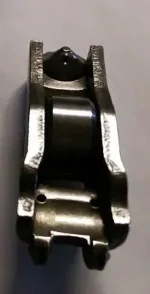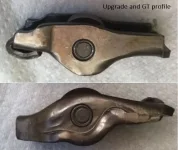Forgot about the gen I modular. I recall even the old flathead v8 engineer was involved in the modular design though maybe more in an honorary role. It revolutionary design utilised a lightweight assembled cam with attached individual lobes.The Ford Modular uses the same arrangement:
DOHC:

SOHC:

These last forever.
The Modular was introduced in 1991, so that's 32 years ago.
Looking at the Mod Ford followers vs. the Pentastar V6 parts I think I am seeing in the geometry less mechanical "dis-advantage" in the lever action of the Ford part - and possibly a larger circumference roller. Hard to tell without having the actual parts on my desk - or better yet on a Nikon optical comparator table. - Ken
(below) Ford 4.6L SOHC followers -
(below) Pentastar V6 Followers -
Last edited:



